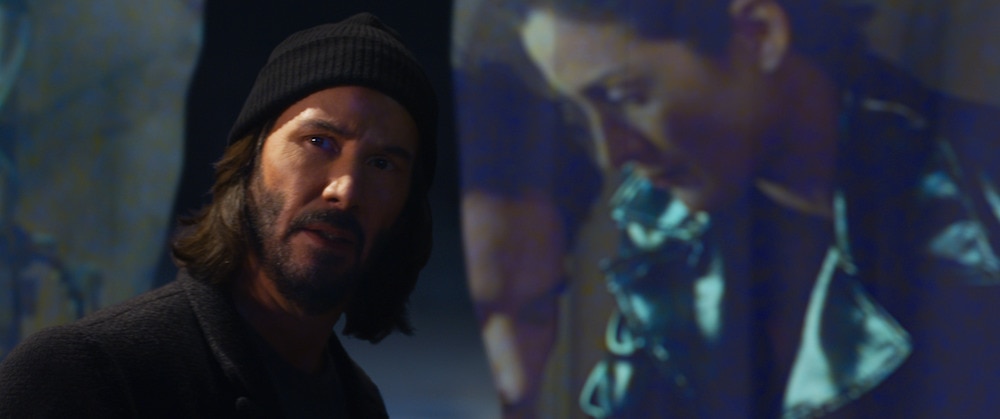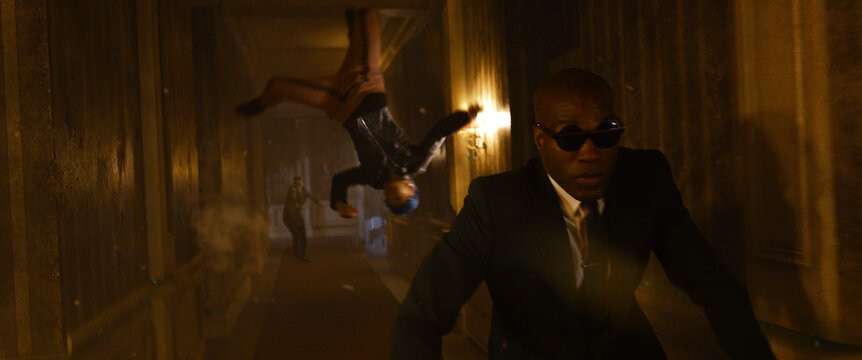Create a free profile to get unlimited access to exclusive videos, sweepstakes, and more!
Why 'The Matrix Resurrections' has more in common with 'Sense8' & 'Cloud Atlas' than with original trilogy
The Matrix Resurrections is now playing in theaters and on HBO Max.

When Lana Wachowski finally decided to plug herself back into The Matrix franchise with Resurrections, she made a conscious effort not to download any of the old stylistic choices she and her sister, Lilly, made on the original Matrix trilogy.
Chatting with The Hollywood Reporter, Resurrections' VFX supervisor Dan Glass opened up about Lana's vision for "a newer" incarnation of the virtual simulation in which Neo (Keanu Reeves) and Trinity (Carrie-Anne Moss) once again find themselves trapped. Apparently the filmmaker wanted a fresh aesthetic that had more in common with recent Wachowski projects than it did with the first three movies.
"Lana’s vision was that it should feel more real," Glass explained. "The Matrix itself in the earlier movies was deliberately studio-based, very inspired by graphic novels. Lana wanted this rendition of the Matrix to feel more familiar to our real world. For her, that meant building off of some of the approaches that we’d followed on some of [the Wachowski's] more recent projects, from Cloud Atlas to Sense8, where the style is almost shooting more like a documentary, [with] a lot of real locations. That was really the premise, actually trying to ground things in more reality."
That philosophy ties into the film's meta jabs at The Matrix's cultural legacy, the polarizing nature of fan discourse, and Hollywood's current obsession with reboots and remakes. "Lana felt that it was better not to try to copy ourselves that directly," Glass said, referring to the dangers of nostalgia-based callbacks. "You kind of risk losing the edge of being self-aware, which comes up [in the story].”
For instance, Resurrections opens with an homage to the opening sequence of the 1999 original, albeit with a few key differences, including an overt lack of bullet-time. The point, Glass added, was to "bring those memories back, but it’s not trying to replicate it exactly." Bugs and Sequoia (two new characters played by Jessica Henwick and Toby Onwumere, respectively) pick up on these discrepancies, prompting the latter to ask: "Why use old code to mirror something new?"
In other words, wink wink-nudge nudge, members of the audience. Similar to the "we're all gonna die from climate change!!!" message of Adam McKay's Don't Look Up, there's nothing particularly subtle or nuanced about Lana's disdain for major studios that try going back to a cinematic well that dried up long ago. Heck, Warner Bros. is directly referenced by Jonathan Groff's Agent Smith, who alludes to the company's decades-long desire for another Matrix sequel. And that's kind of the point: a satirical sledgehammer brought down on the hit-or-miss practice of taking classic IP and re-skinning it just enough so that it can be sold back to consumers.
"I think everyone has a sense of humor, right?" producer James McTeigue told Fandango when asked how WB reacted to becoming the butt of a joke. "It's kind of like taking offense to something like the Book of Mormon or something like that. At some point you just have to go, 'Oh, that's a pretty funny joke.' We liked it. And I think they appreciated it — that it was in with the meta-ness of everything else that we were saying. So no, they were great, never said anything about it, was never any kind of a censorship around us using them."
The Matrix Resurrections is now playing in theaters and on HBO Max. To date, the movie has brought in $31.4 million domestically and $74.6 million internationally for a global box office of $106 million.



























